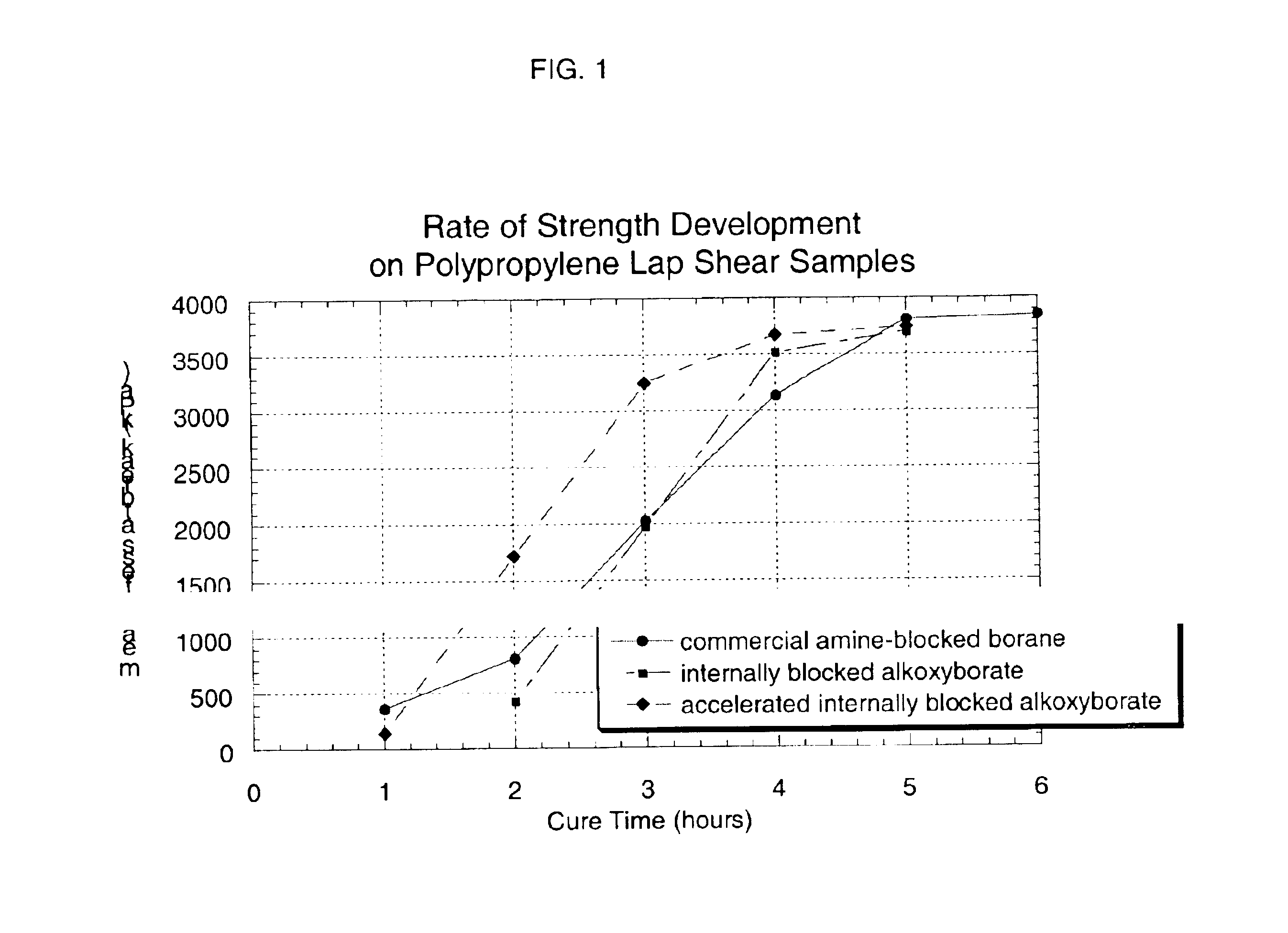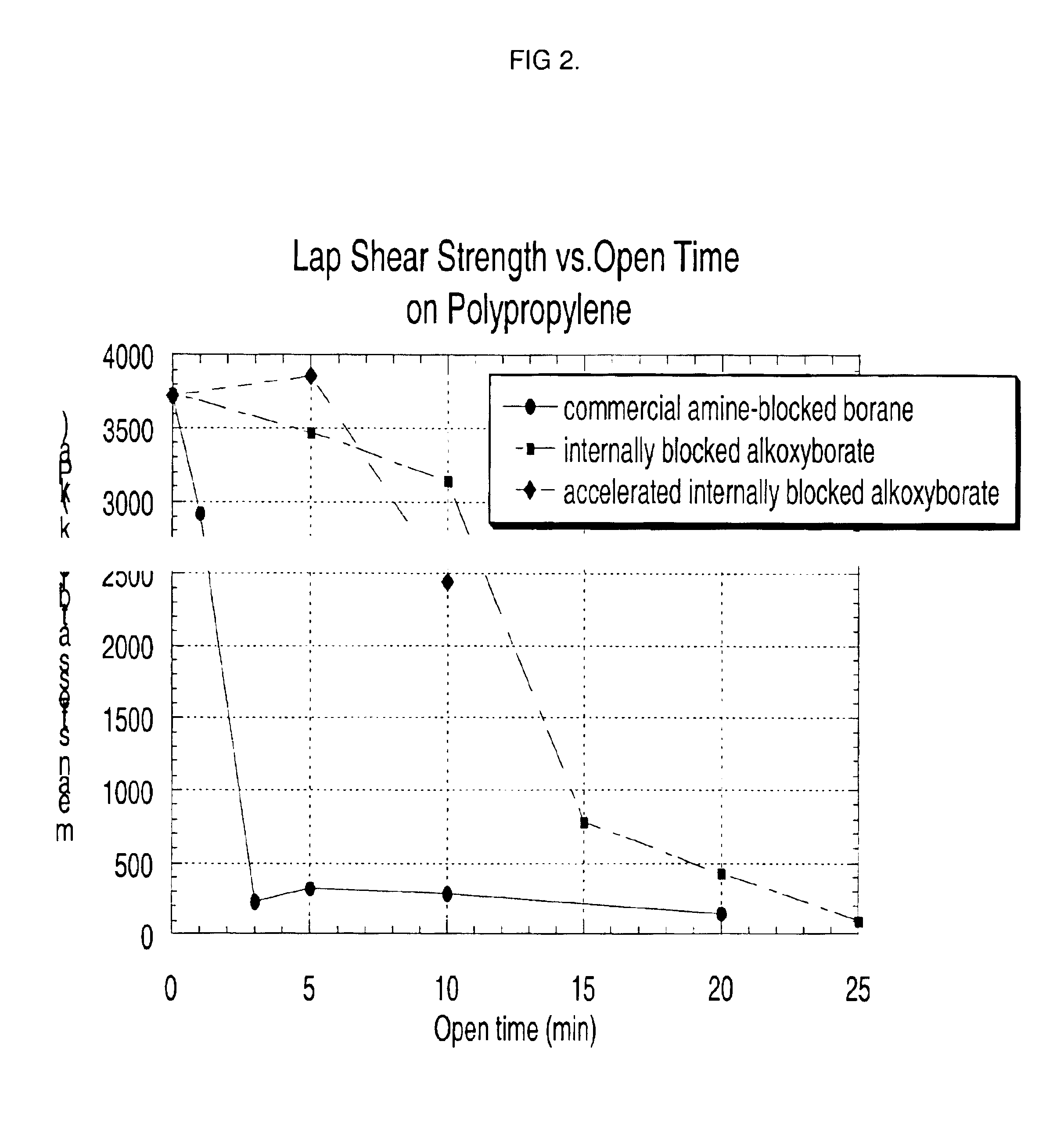Internally blocked organoborate initiators and adhesives therefrom
an organoborate initiator and organoborate technology, applied in the field of internal blockage organoborate initiators and adhesives therefrom, can solve the problems of relatively poor air stability of conventional alkoxyborates, and achieve the effects of rapid polymerization rate, rapid polymerization rate, and reasonable stability of initiator activity
- Summary
- Abstract
- Description
- Claims
- Application Information
AI Technical Summary
Benefits of technology
Problems solved by technology
Method used
Image
Examples
example 1
Sodium diethyl(1-propanolato(2-)-C3,O)borate
The entire reaction is performed under a dry, inert atmosphere, with care taken to assure that oxygen and water are not allowed to contaminate the reaction or reagents. The reaction is conducted under an argon atmosphere in a jacketed vessel equipped with a stir bar, condenser with argon connection, septum port, and thermometer.
Triethylborane (0.3 mol) in THF was charged to a 500 ml glass reactor and heated to 60-65° C. Pivalic acid (0.005 mol) in toluene was added to the reactor and allowed to react for 15 minutes. Neat 3-bromo-1-propanol (0.3 mol) was added slowly and the reaction allowed to stir at 65-75° C. under reflux for 90 minutes. The reaction was cooled to 30-35° C. and a 30% sodium metal dispersion (0.65 mol) in toluene was added slowly while maintaining the reactor contents below 50° C. The reaction was heated to reflux and allowed to stir for 60 minutes, followed by cooling to around 40° C. and the product mixture added to 5.5...
examples 1-7
are Illustrated by:
Internally blocked borates in which X is CH2 can be made by more than one route. The reaction of diborane with 2,4-dimethyl-1,4-pentadiene, followed by reaction with ethylene, and then ethyl sodium results in Example 6 in Table 2. The intermediate cyclic hydroborane
is known. This intermediate can be used in accordance with the invention for synthesizing a variety of bi-cyclic borates, for example, by reaction with an olefin and ethyl sodium as can be seen in Examples 11-15 below. The reaction of triethylborane with borane dimethylsulfide is known and results in the formation of diethylborane. Diethylborane can be reacted with 4-bromo-1-butene and then sodium to produce the internally blocked structure of Example 7.
An internally blocked thioborate is formed by reacting triethylborane with borane dimethylsulfide followed by reacting with 4-bromo-1-butene, and then with thiourea, followed by sodium hydroxide, resulting in the internally blocked borate in which X is ...
example 9
Sodium di(3-hydroxypropyl)(1-propanolato(2-)-C3,O)borate
A 250-mL round-bottom flask was fit with a stir bar and sealed with a septum. The flask was purged with nitrogen for 30 min and placed in a solid carbon dioxide-isopropanol bath. Borane (150 mL of a 1 M solution in THF, 150 mmol) was added to the reaction flask via syringe. Allyl acetate (49.5 g, 495 mmol), which had been sparged with nitrogen, was added to the reaction flask via syringe. The reaction was allowed to slowly come to room temperature overnight. The reaction was stirred at room temperature for 4 days. The solvent was removed under vacuum. The reaction flask was taken into an argon box. A solution of 4.08 g (170 mmol) of sodium hydride in 40 mL of ethanol (thus, a solution of sodium ethoxide in ethanol) was added to the reaction flask. A white precipitate formed. The reaction flask was fitted with a distillation head and a receiving flask. The apparatus was removed from the argon box and the reaction was heated with...
PUM
| Property | Measurement | Unit |
|---|---|---|
| surface energy | aaaaa | aaaaa |
| charge | aaaaa | aaaaa |
| reactivity | aaaaa | aaaaa |
Abstract
Description
Claims
Application Information
 Login to view more
Login to view more - R&D Engineer
- R&D Manager
- IP Professional
- Industry Leading Data Capabilities
- Powerful AI technology
- Patent DNA Extraction
Browse by: Latest US Patents, China's latest patents, Technical Efficacy Thesaurus, Application Domain, Technology Topic.
© 2024 PatSnap. All rights reserved.Legal|Privacy policy|Modern Slavery Act Transparency Statement|Sitemap



